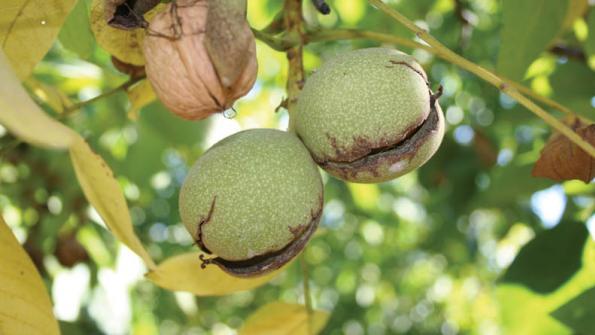
It may pay to give mating disruption of codling moth another look
Some growers consider mating disruption to be more expensive than their conventional insecticide programs. Working with manufacturers of the aerosol dispensers, Grant and his colleagues conducted trials to assess the efficacy of lower pheromone rates.

If you’ve been holding off on the use of pheromones emitted by aerosol dispensers to control codling moth by disrupting mating, due to concerns about cost, suitability in tall trees or other reasons, you might want to reconsider.
New formulations have lowered the cost of this technology without reducing effectiveness, reports Joe Grant, University of California Cooperative Extension farm advisor for San Joaquin County.
Mating disruption uses a natural sex attractant to lower reproduction rates by making it more difficult and time-consuming for male moths to locate females. Mating disruption technology is a valuable tool in walnut pest management, he notes. When used in conjunction with the judicious application of insecticides, it makes control of codling moth more effective and sustainable
Although this technology was registered in walnuts in 2005, growers have been slow to adopt it, Grant adds. For the past three years, he and his colleagues have been working with growers to learn why.
Some growers consider mating disruption to be more expensive than their conventional insecticide programs. Working with manufacturers of the aerosol dispensers, Grant and his colleagues conducted trials to assess the efficacy of lower pheromone rates.
Based on the results of these trials, manufacturers have begun marketing lower rate formulations. They first came on the market this year, Grant reports.
“The new formulations cost less than the original ones and are just as effective,” he says. “For growers comparing the costs and benefits of pheromones versus insecticides, this should change the calculation.”
Some walnut growers have reported difficulties getting pheromones to work well in tall-canopied orchards. Recommendations call for hanging the aerosol dispensers in the top one-third of the canopy.
“We recognize this can be challenging in walnuts, where tree heights may reach up to 50 feet,” Grant says. “But, when growers do this, we’ve seen good evidence of effective suppression throughout the canopy. Before we conclude that the occasional observations of poor performance of pheromones in tall orchards is due to inadequate pheromone distribution in the tops of tall trees, I think we need to also ask if poor spray coverage of ground-based supplemental codling moth treatments up there might also be contributing to the problem. In such cases, aerial application of the insecticides may be needed.”
Some growers are concerned that replacing codling moth insecticide sprays with pheromones will allow walnut husk fly numbers, which have been increasing in walnut orchards, to rise even more, Grant notes.
“This idea makes sense,” he says. “But, it was more true in the past, when broad-spectrum materials were available for controlling codling moth,” says Grant. “In those days, growers could spray for codling moth and reasonably expect at least some incidental control of husk fly, even though the timing of those older codling moth sprays wasn’t ideal for controlling walnut husk fly, except, perhaps, late in the season.”
The new chemistries of today’s insecticides are much more selective. Consequently, many of the current products designed to control codling moth are much less effective against walnut husk fly, and vice-versa, Grant notes.
“I prefer to look at it this way,” he says. “Using mating disruption to control codling moth can actually lead to more effective control of walnut husk fly. It allows you to spray materials designed specifically for each pest at the times when these chemicals are most effective.”
Mating disruption with aerosol dispensers is most successful in large, uniform orchards with a square shape (as opposed to a narrow rectangular shape), and with relatively low to moderate codling moth populations, Grant notes. For varieties that are highly susceptible to codling moth damage, such as Ashley, Payne, Serr and Vina, or in orchards with histories of large codling moth populations or previous economically-significant codling moth damage, he recommends transitioning to mating disruption by using both mating disruption and supplemental chemical control as needed the first two or three years to reduce population levels. “Used in this way,” Grant says, “most growers have reduced the number of codling moth sprays they apply, and many have eliminated them entirely.”
“We think we’ve brought mating disruption using aerosol dispensers to a point where it’s less expensive than it used to be,” Grant says. “We’ve also learned more about how to make mating disruption work well in a variety of orchard situations. As such, I think growers can now consider mating disruption a proven, viable and cost-effective IPM tool worth considering for managing codling moth in their walnut orchards.”
About the Author(s)
You May Also Like



